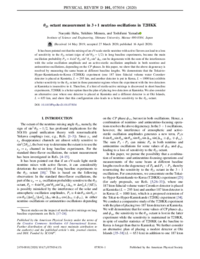θ 23 octant measurement in 3 + 1 neutrino oscillations in T2HKK
number of downloads : ?
Use this link to cite this item : https://ir.lib.shimane-u.ac.jp/52541
| ID | 52541 |
| File | |
| language |
eng
|
| Author |
Mimura, Yukihiro
Institute of Science and Engineering, Shimane University, Matsue 690-8504, Japan
|
| Description | It has been pointed out that the mixing of an eV-scale sterile neutrino with active flavors can lead to a loss of sensitivity to the θ23 octant (sign of sin2θ23 − 1=2) in long baseline experiments, because the main oscillation probability P0 ¼ 4 sin2 θ23 sin2 θ13 sin2 Δ31 can be degenerate with the sum of the interferences with the solar oscillation amplitude and an active-sterile oscillation amplitude in both neutrino and antineutrino oscillations, depending on the CP phases. In this paper, we show that the above degeneracy is resolved by measuring the same beam at different baseline lengths. We demonstrate that the Tokai-to-Hyper-Kamiokande-to-Korea (T2HKK) experiment (one 187 kton fiducial volume water Cerenkov detector is placed at Kamioka, L ¼ 295 km, and another detector is put in Korea, L ∼ 1000 km) exhibits a better sensitivity to the θ23 octant in those parameter regions where the experiment with the two detectors at Kamioka is insensitive to it. Therefore, if a hint of sterile-active mixings is discovered in short baseline experiments, T2HKK is a better option than the plan of placing two detectors at Kamioka.We also consider an alternative case where one detector is placed at Kamioka and a different detector is at Oki Islands, L ¼ 653 km, and show that this configuration also leads to a better sensitivity to the θ23 octant.
|
| Journal Title |
PHYSICAL REVIEW D
|
| Volume | 101
|
| Issue | 7
|
| ISSN | 2470-0010
|
| ISSN(Online) | 2470-0029
|
| Published Date | 2020-04-16
|
| DOI | |
| Publisher | American Physical Society
|
| NII Type |
Journal Article
|
| Format |
PDF
|
| Relation | |
| Text Version |
出版社版
|
| Gyoseki ID | e37169
|
| OAI-PMH Set |
Faculty of Science and Engineering
|
